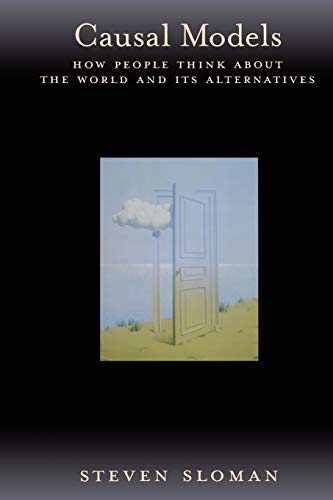causal models people think von sloman steven (7 Ergebnisse)
Suchfilter
Produktart
- Alle Product Types
- Bücher (7)
- Magazine & Zeitschriften (Keine weiteren Ergebnisse entsprechen dieser Verfeinerung)
- Comics (Keine weiteren Ergebnisse entsprechen dieser Verfeinerung)
- Noten (Keine weiteren Ergebnisse entsprechen dieser Verfeinerung)
- Kunst, Grafik & Poster (Keine weiteren Ergebnisse entsprechen dieser Verfeinerung)
- Fotografien (Keine weiteren Ergebnisse entsprechen dieser Verfeinerung)
- Karten (Keine weiteren Ergebnisse entsprechen dieser Verfeinerung)
- Manuskripte & Papierantiquitäten (Keine weiteren Ergebnisse entsprechen dieser Verfeinerung)
Zustand Mehr dazu
- Neu (4)
- Wie Neu, Sehr Gut oder Gut Bis Sehr Gut (1)
- Gut oder Befriedigend (2)
- Ausreichend oder Schlecht (Keine weiteren Ergebnisse entsprechen dieser Verfeinerung)
- Wie beschrieben (Keine weiteren Ergebnisse entsprechen dieser Verfeinerung)
Einband
Weitere Eigenschaften
- Erstausgabe (1)
- Signiert (Keine weiteren Ergebnisse entsprechen dieser Verfeinerung)
- Schutzumschlag (1)
- Angebotsfoto (2)
Sprache (1)
Gratisversand
Land des Verkäufers
Verkäuferbewertung
-
Causal Models : How People Think about the World and Its Alternatives
Verlag: Oxford University Press, Incorporated, 2005
ISBN 10: 0195183118 ISBN 13: 9780195183115
Sprache: Englisch
Anbieter: Better World Books, Mishawaka, IN, USA
EUR 6,64
Währung umrechnenKostenlos für den Versand innerhalb von/der USAAnzahl: 1 verfügbar
In den WarenkorbZustand: Good. Former library book; may include library markings. Used book that is in clean, average condition without any missing pages.
-
Causal Models: How People Think About the World and Its Alternatives
Anbieter: WorldofBooks, Goring-By-Sea, WS, Vereinigtes Königreich
EUR 17,82
Währung umrechnenEUR 6,44 für den Versand von Vereinigtes Königreich nach USAAnzahl: 1 verfügbar
In den WarenkorbPaperback. Zustand: Very Good. The book has been read, but is in excellent condition. Pages are intact and not marred by notes or highlighting. The spine remains undamaged.
-
Causal Models: How People Think About the World and Its Alternatives
Anbieter: Ria Christie Collections, Uxbridge, Vereinigtes Königreich
EUR 30,22
Währung umrechnenEUR 13,78 für den Versand von Vereinigtes Königreich nach USAAnzahl: Mehr als 20 verfügbar
In den WarenkorbZustand: New. In.
-
CAUSAL MODELS: HOW PEOPLE THINK ABOUT THE WORLD AND ITS ALTERNATIVES.
Verlag: Fine In Fine Dust Wrapper., New York,, 2005
ISBN 10: 0195183118 ISBN 13: 9780195183115
Sprache: Englisch
Anbieter: Burwood Books, Wickham Market, Vereinigtes Königreich
Verbandsmitglied: PBFA
Erstausgabe
EUR 33,18
Währung umrechnenEUR 20,13 für den Versand von Vereinigtes Königreich nach USAAnzahl: 1 verfügbar
In den WarenkorbHardcover. Zustand: Fine. First Edition. Hardback. Dust Jacket. 8vo. Some figures throughout. ISBN: 0-19-518311-8 Pages: 224 Fine in fine dust wrapper.
-
Causal Models: How People Think about the World and Its Alternatives
Anbieter: Ria Christie Collections, Uxbridge, Vereinigtes Königreich
EUR 50,97
Währung umrechnenEUR 13,78 für den Versand von Vereinigtes Königreich nach USAAnzahl: Mehr als 20 verfügbar
In den WarenkorbZustand: New. In.
-
Causal Models : How People Think about the World and Its Alternatives
Verlag: Oxford University Press Jul 2005, 2005
ISBN 10: 0195183118 ISBN 13: 9780195183115
Sprache: Englisch
Anbieter: AHA-BUCH GmbH, Einbeck, Deutschland
EUR 71,21
Währung umrechnenEUR 62,50 für den Versand von Deutschland nach USAAnzahl: 2 verfügbar
In den WarenkorbBuch. Zustand: Neu. Neuware - Human beings are active agents who can think. To understand how thought serves action requires understanding how people conceive of the relation between cause and effect, that is, between action and outcome.In cognitive terms, the question becomes one of how people construct and reason with the causal models we use to represent our world. A revolution is occuring in how statisticians, philosophers, and computer scientists answer this question. These fields have ushered in new insights about causal models by thinking about how to represent causal structure mathematically, in a framework that uses graphs and probability theory to develop what are called 'causal Bayesian networks'. The framework starts with the idea that the purpose of causal structure is to understand and predict the effects of intervention: How does intervening on one thing affect other things This question is not merely about probability (or logic), but about action. The framework offers a new understanding of mind: Thought is about the effects of intervention, so cognition is thereby intimately tied to actions that take place either in the actual physical world or in imagination, in counterfactual worlds.In this book, Steven Sloman offers a conceptual introduction to the key mathematical ideas in the framework, presenting them in a non-technical way, by focusing on the intuitions rather than the theorems. He tries to show why the ideas are important to understanding how people explain things, and why it is so central to human action to think not only about the world as it is, but also about the world as it could be. Sloman also reviews the role of causality, causal models, and intervention in the basic human cognitive functions: decision making, reasoning, judgement, categorization, inductive inference, language, and learning. In short, this book offers a discussion about how people think, talk, learn, and explain things in causal terms - in terms of action and manipulation.
-
Causal Models: How People Think About The World And Its Alternatives
Anbieter: Revaluation Books, Exeter, Vereinigtes Königreich
EUR 132,03
Währung umrechnenEUR 28,76 für den Versand von Vereinigtes Königreich nach USAAnzahl: 2 verfügbar
In den WarenkorbHardcover. Zustand: Brand New. 1st edition. 212 pages. 9.25x6.25x0.75 inches. In Stock.





